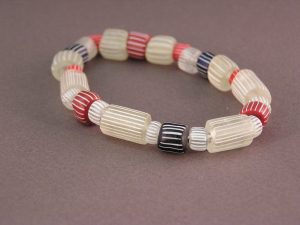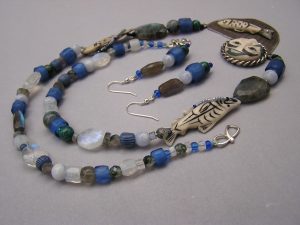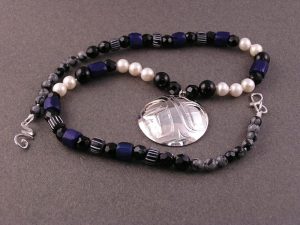Gooseberries are possibly my favorite trade bead. A fact I find kind of strange because they are a pale color and I usually go for the flashy colors, being basically a Raven personality.

Maybe the fact that the good ones are hard to find makes them appealing, but then all trade beads are hard to find! The translucent whitish ones with white stripes are my favorite. Gooseberries also come in an opaque brick red with white stripes, a deep opaque cobalt blue with white stripes and black with the required stripes. I’ve also seen them in a beautiful semi transparent creamy yellowish green, a gorgeous transparent pink and some with a purple tinge. They’re all so beautiful. They all seem to have that essence typical of trade beads that scream of past lives and adventures they’ve been on!

It seems Gooseberries don’t fall into the category that most trade beads occupy, having been originally made in Venice. It’s true that Murano, Venice is the motherland of glass trade bead manufacturers who developed and produced the most exquisite glass beads of the era and they heavily guarded their secret formulas and techniques in order to remain at the top of the game. As one can imagine there were major attempts to pirate not only the secrets but the skilled labor to other countries to set up the manufacturing so they also could reap the incredible harvest that was the trade bead industry in Europe, 1500 – 1800 AD. There are horror stories of imprisonments of defectors and their families if they tried to escape with secrets from Murano glass works. In my research of Gooseberries I’ve found that yes, striped beads were made in Murano, Venice, but there is extensive archaeological evidence that huge numbers were made in Amsterdam, Holland. It is fact that an Italian glassblower, named Obizzo, was given permission to build a glass factory in Amsterdam in 1597 and the glass blowing and bead making industry started to boom. I’m sure the Italian glass mafia was after him and his family! Beads were one of the main trade items to the Americas and were advertised in trade journals as beads from “Holland” for sale 1717 – 1727 AD. The Dutch explorers and seafaring captains put barrels of these trade beads in their ships holds and barrels of these Dutch made trade beads were sold to the English for the same reasons. Trade beads were as legal tender in the Americas and Africa. The glass houses operated in Amsterdam throughout the 18th century still producing beads. Some of the beads found in archaeological digs were the famous Chevron Pater Noster beads, Gooseberries in the traditional colors, monochrome opaque blue beads and tubes, also various striped beads.


My research has shown to me that the technique of making Gooseberry beads was originally stringers of white glass adhered lengthwise by heat to the outside of a blown lump of the basic colored mixture of soda and sand glass, then heated just to melting when the blown lump was then pulled into a long tube, cooled, cut into segments, tumbled and polished. The hole created from blowing into the melted glass lump stays all the way to the end of the pulled tube. The stripes are part of the glass bead, not applied after or painted on. I’ve noticed that as time went on, beads recovered from documented sites having been manufactured after the 1700’s, the mandrel wound Gooseberries make more of an appearance. They have the same stripes as part of their construction but a beautiful roundness gives them a different character than the cut tubes.

Have you ever seen a real Gooseberry fruit? I happen to live on a peninsula called Gooseberry Point in Washington State. Occasionally when wandering about in the woods one can get snagged by a wild gooseberry bush because they have stickers all over the branches. The trick is to notice where it is and come back in the summer to find gorgeous translucent whitish green, very tart berries with white stripes maturing on the bush. If you wait and come back a bit later the berries turn pinkish red and that is the delicious stage, but if you’re later in the season maybe you’ll get a few deep purple ones that aren’t so tasty yet very beautiful. The birds love them and usually beat you to them dropping their seeds around in the woods to grow more plants. Gooseberry plants can be bought at nurseries to plant in your garden and are desired because they make up into fantastic pies. I totally understand why the glass-makers chose to make beads that looked like Gooseberries, not only for their attractive stages of color change, but also maybe to remind them of their delicious quality and sale ability.
Author: Janet Walker | Archive | Email | Voicemail #17
Silversmith, Carver, Designer of Cast Precious Metals and Jewelry